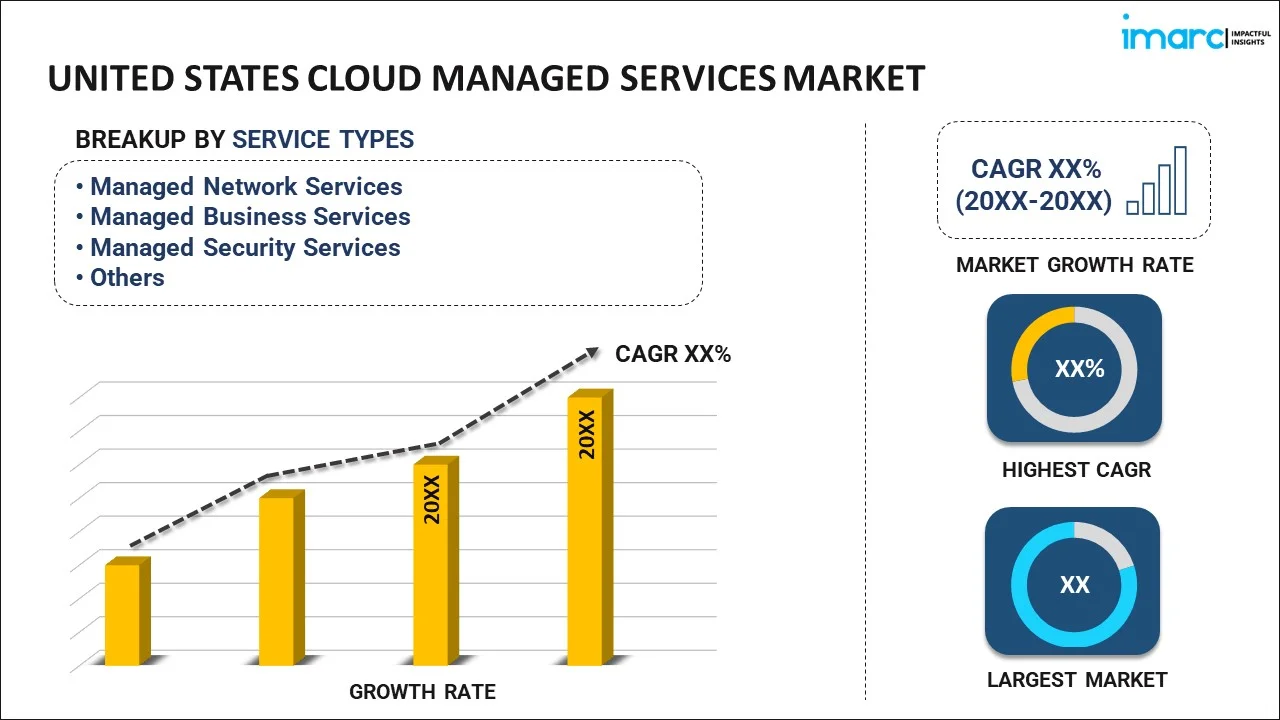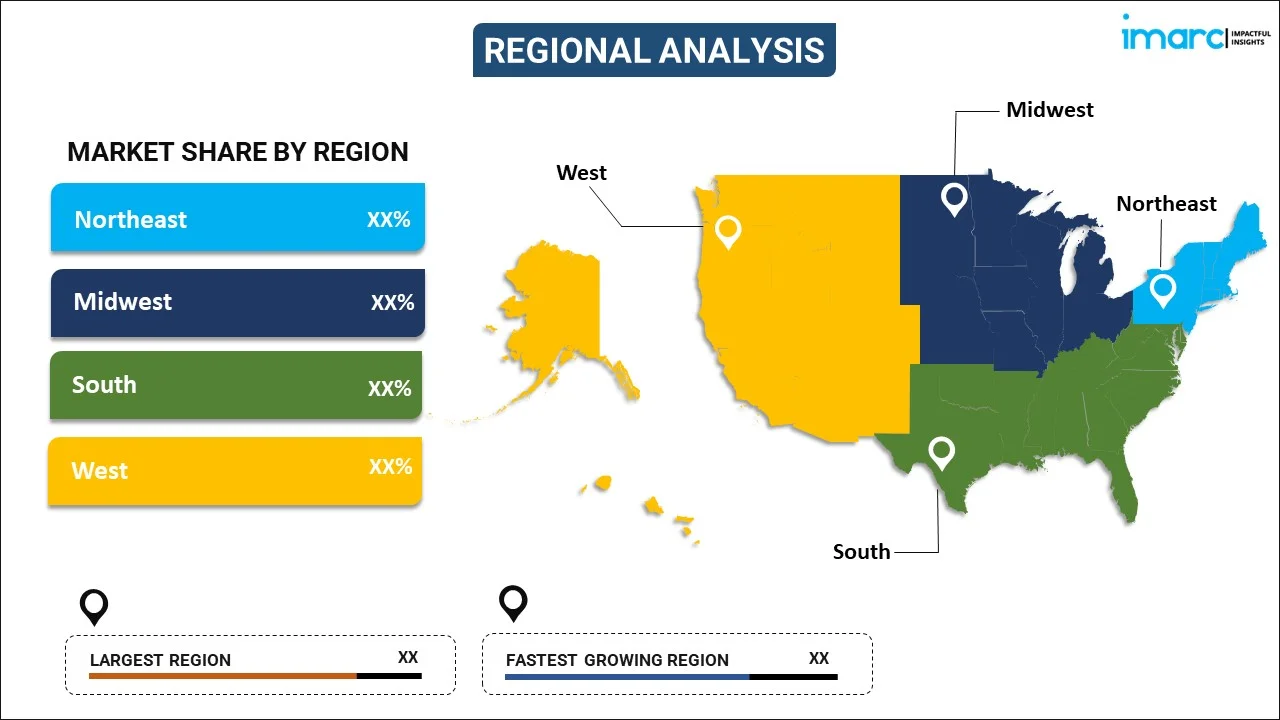
United States Cloud Managed Services Market Report by Service Type (Managed Network Services, Managed Business Services, Managed Security Services, Managed Infrastructure Services, Managed Mobility Services, Managed Communication and Collaboration Services), Deployment Model (Private Cloud, Public Cloud), Organization Size (Large Enterprises, Small and Medium-sized Enterprises), Vertical (Retail and Consumer Goods, BFSI, Telecom, Government and Public Sector, Healthcare and Lifesciences, Manufacturing, Energy and Utilities, IT, and Others), and Region 2024-2032
Market Overview:
United States cloud managed services market size reached US$ 13.1 Billion in 2023. Looking forward, IMARC Group expects the market to reach US$ 32.3 Billion by 2032, exhibiting a growth rate (CAGR) of 11.11% during 2024-2032. The rising focus among government bodies on security and compliance, along with the growing generation of large volumes of data, is primarily driving the market growth.
|
Report Attribute
|
Key Statistics
|
|---|---|
|
Base Year
|
2023 |
|
Forecast Years
|
2024-2032 |
|
Historical Years
|
2018-2023
|
| Market Size in 2023 | US$ 13.1 Billion |
| Market Forecast in 2032 | US$ 32.3 Billion |
| Market Growth Rate (2024-2032) | 11.11% |
Cloud managed services involve outsourcing a range of IT responsibilities associated with cloud infrastructure and applications to third-party service providers. These services cover diverse tasks like deploying, monitoring, maintaining, securing, backing up data, and recovering from disasters in the cloud. Additionally, they include the management of virtualized components, such as servers, storage, and networking resources. The purpose is to address the technical complexities of cloud management, enabling organizations to concentrate on their primary business goals. These services facilitate the adjustment of cloud resources based on demand, ensuring optimal performance without unnecessary provisioning.
United States Cloud Managed Services Market Trends:
The United States cloud managed services market is experiencing robust growth, driven by the increasing adoption of cloud technologies across various industries. Apart from this, numerous organizations are turning to cloud managed services to efficiently delegate their IT tasks and responsibilities, ranging from deployment to security, to third-party service providers. Additionally, this trend is fueled by the recognition that specialized expertise is required to navigate the complexities of cloud infrastructure and applications. Besides this, as businesses seek to enhance their agility and scalability, cloud managed services become instrumental in managing virtualized components like servers, storage, and networking resources, which is acting as another significant growth-inducing factor. Moreover, the market is witnessing a surge in demand for services that cover monitoring, maintenance, data backup, and disaster recovery, allowing companies to focus on their core business objectives. Furthermore, the flexibility offered by these services enables organizations to scale their cloud resources according to demand, ensuring optimal performance without the risk of overprovisioning. With the continuous evolution of technology and the increasing importance of digital transformation, the United States cloud managed services market is poised for sustained expansion, playing a pivotal role in shaping the future of IT infrastructure management in the country over the forecasted period.
United States Cloud Managed Services Market Segmentation:
IMARC Group provides an analysis of the key trends in each segment of the market, along with forecasts at the country level for 2024-2032. Our report has categorized the market based on service type, deployment model, organization size, and vertical.
Service Type Insights:

- Managed Network Services
- Managed Business Services
- Managed Security Services
- Managed Infrastructure Services
- Managed Mobility Services
- Managed Communication and Collaboration Services
The report has provided a detailed breakup and analysis of the market based on the service type. This includes managed network services, managed business services, managed security services, managed infrastructure services, managed mobility services, and managed communication and collaboration services.
Deployment Model Insights:
- Private Cloud
- Public Cloud
A detailed breakup and analysis of the market based on the deployment model have also been provided in the report. This includes private cloud and public cloud.
Organization Size Insights:
- Large Enterprises
- Small and Medium-sized Enterprises
The report has provided a detailed breakup and analysis of the market based on the organization size. This includes large enterprises and small and medium-sized enterprises.
Vertical Insights:
- Retail and Consumer Goods
- BFSI
- Telecom
- Government and Public Sector
- Healthcare and Lifesciences
- Manufacturing
- Energy and Utilities
- IT
- Others
A detailed breakup and analysis of the market based on the vertical have also been provided in the report. This includes retail and consumer goods, BFSI, telecom, government and public sector, healthcare and lifesciences, manufacturing, energy and utilities, IT, and others.
Regional Insights:

- Northeast
- Midwest
- South
- West
The report has also provided a comprehensive analysis of all the major regional markets, which include the Northeast, Midwest, South, and West.
Competitive Landscape:
The market research report has also provided a comprehensive analysis of the competitive landscape. Competitive analysis such as market structure, key player positioning, top winning strategies, competitive dashboard, and company evaluation quadrant has been covered in the report. Also, detailed profiles of all major companies have been provided.
United States Cloud Managed Services Market Report Coverage:
| Report Features | Details |
|---|---|
| Base Year of the Analysis | 2023 |
| Historical Period | 2018-2023 |
| Forecast Period | 2024-2032 |
| Units | US$ Billion |
| Scope of the Report | Exploration of Historical Trends and Market Outlook, Industry Catalysts and Challenges, Segment-Wise Historical and Future Market Assessment:
|
| Service Types Covered | Managed Network Services, Managed Business Services, Managed Security Services, Managed Infrastructure Services, Managed Mobility Services, Managed Communication and Collaboration Services |
| Deployment Models Covered | Private Cloud, Public Cloud |
| Organization Sizes Covered | Large Enterprises, Small and Medium-sized Enterprises |
| Verticals Covered | Retail and Consumer Goods, BFSI, Telecom, Government and Public Sector, Healthcare and Lifesciences, Manufacturing, Energy and Utilities, IT, Others |
| Regions Covered | Northeast, Midwest, South, West |
| Customization Scope | 10% Free Customization |
| Report Price and Purchase Option | Single User License: US$ 3699 Five User License: US$ 4699 Corporate License: US$ 5699 |
| Post-Sale Analyst Support | 10-12 Weeks |
| Delivery Format | PDF and Excel through Email (We can also provide the editable version of the report in PPT/Word format on special request) |
Key Questions Answered in This Report:
- How has the United States cloud managed services market performed so far and how will it perform in the coming years?
- What has been the impact of COVID-19 on the United States cloud managed services market?
- What is the breakup of the United States cloud managed services market on the basis of service type?
- What is the breakup of the United States cloud managed services market on the basis of deployment model?
- What is the breakup of the United States cloud managed services market on the basis of organization size?
- What is the breakup of the United States cloud managed services market on the basis of vertical?
- What are the various stages in the value chain of the United States cloud managed services market?
- What are the key driving factors and challenges in the United States cloud managed services?
- What is the structure of the United States cloud managed services market and who are the key players?
- What is the degree of competition in the United States cloud managed services market?
Key Benefits for Stakeholders:
- IMARC’s industry report offers a comprehensive quantitative analysis of various market segments, historical and current market trends, market forecasts, and dynamics of the United States cloud managed services market from 2018-2032.
- The research report provides the latest information on the market drivers, challenges, and opportunities in the United States cloud managed services market.
- Porter's five forces analysis assist stakeholders in assessing the impact of new entrants, competitive rivalry, supplier power, buyer power, and the threat of substitution. It helps stakeholders to analyze the level of competition within the United States cloud managed services industry and its attractiveness.
- Competitive landscape allows stakeholders to understand their competitive environment and provides an insight into the current positions of key players in the market.
Need more help?
- Speak to our experienced analysts for insights on the current market scenarios.
- Include additional segments and countries to customize the report as per your requirement.
- Gain an unparalleled competitive advantage in your domain by understanding how to utilize the report and positively impacting your operations and revenue.
- For further assistance, please connect with our analysts.
 Inquire Before Buying
Inquire Before Buying
 Speak to an Analyst
Speak to an Analyst
 Request Brochure
Request Brochure
 Request Customization
Request Customization




.webp)




.webp)












